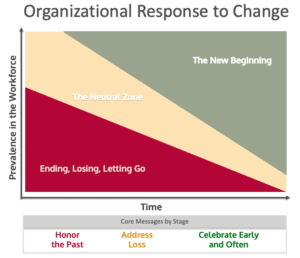19 Nov How to Overcome Resistance to Change
How To Overcome Resistance To Change
Flex Your Change Muscles to Be More Resilient and Creative
There are at least two things you can count on within your organization. The first is change, and the second is that some people within your organization will resist change. However, because long-term growth is often contingent on your organization evolving over time, it is important that people in your organization learn to embrace change and bring others along. Overcoming resistance is made easier when you guide people through the entire process, from beginning to end.
In our work with organizations, we see leaders who commit to making positive, organization-wide changes. Such changes might include improving systems and processes, implementing new technology, and adjusting to economic and societal shifts. These are changes that provide growth opportunities for both the organization and the people who work there.
“In order to take advantage of the positive pressure of change, you must be prepared to help your team members overcome resistance.”
Change drives innovation and development. It requires regular improvements to your operations in a world that is constantly evolving. In order to take advantage of the positive pressure of change, you must be prepared to help your team members overcome resistance. Most of their change resistance is generated from fear of the unknown, and fear of loss driven by that change.
Here are some tools you and your organizational leaders can use to build a resilient, confident, and trusting team that sees change as a catalyst for growth.
Overcome Resistance to Change with Effective Communication
Overcoming resistance to change requires highly effective communication to address the fear and sense of loss of everyone impacted by the change. When there is change, or even the threat of change, many people feel anxious. Their sense of psychological safety may be compromised. Some may react emotionally, concerned about what they may be losing in the context of that change.
To better describe this process, neuroscientist David Rock developed the SCARF model to describe five domains of human social experience. Given that we react to social threats in the same way we might react to physical threats, organizational changes can produce strong emotional reactions when we are focused on what we might lose as a result. In the workplace, this translates to a decrease in motivation, inability to concentrate, and decreased productivity. None of these will help you achieve your goals.
Here is a breakdown of the SCARF method and how to apply it to your organization.
The SCARF Method:
Status refers to how people see themselves, and how they are seen by others. To increase status, you can provide people with learning opportunities to enhance their expertise and a platform to teach others. Or, give them credit for their ideas and accomplishments.
Certainty refers to how confident people are of where they are going and what will happen next. To increase certainty, it is important to set clear expectations and guidelines so that regardless of what is happening outside of their personal workspace, people feel they are on the right track and clearly know what their role is.
Autonomy refers to how much control people feel they have over their environment. To increase autonomy, allow people to control some aspects of their work life such as setting their working hours or deciding how a particular task will be completed, or giving them input on the timeline or team for a project.
Relatedness refers to how connected people feel to others within their organization, and to the organization as a whole. You can support relatedness by including people in the evolution of your organization’s vision and in how you describe the future in a way that includes everyone.
Fairness refers to how just people feel decisions involving them are. Meeting expectations or following up on the promises you make increases their sense of fairness and reduces a lack of trust. Providing compensation that matches their capabilities, and being transparent about the decision making process and priorities promote a greater sense of fairness in the workplace.
Change and Fear of the Unknown
Examining the stages of transition that people go through when faced with change can help provide effective ways for making the transition less about loss and more about the potential for growth. Transcend has adapted the linear Bridges Transition Model to look at how organizations process change.

The Endings: The first step to overcome resistance to change during a transitional period is letting go. In this step, referred to as “the endings,” leaders should focus first on the case for change. Why is the change happening? What would be the consequence of not changing? What is the better future enabled by this change?
During this stage, when emotions are the strongest, people need to reflect on the past and address their feelings of loss. This presents an opportunity for your management teams to exercise emotional intelligence. They should acknowledge their fears and also acknowledge all the great work that has gone into the current mode. By honoring the past, leaders help dampen the anger and sense of loss, and help the organization move into the next phase – the neutral zone. They should paint a picture of the future and how those within their organization will contribute to build it. As a result, everyone is better able to see themselves as part of the end goal and feel more valued.
Neutral Zone: Once people come to terms with what they have lost, they enter the “neutral zone.” This represents the space in between the sense of loss and the celebration of gains. The changes are not yet fully operational. At this point, people feel torn and attempt to hold on tight to the old, while struggling to embrace the new.
Here, it is essential to ensure the people within your organization feel supported as they learn new skills, new processes, and a new sense of identity. Listen for pain points and challenges they are experiencing. Look for solutions that help overcome these problems quickly. Set short-term goals that will help to build confidence, and provide regular feedback so they can measure their day-to-day progress. This support will help them enter the final stage to overcome resistance to change.
New Beginnings: In this final stage, people embrace change and begin to energetically work towards the organization’s new vision. During this time, it is important to celebrate early and often. This encourages progress and creates a sense of positive momentum. Celebrate the team’s successes by rewarding progress and clearly communicate each person’s role in contributing to long-term goals. Without sufficient recognition of success, small setbacks and new challenges may lead people to regress to previous stages.
Smooth Transitions Help Overcome Resistance to Change
The above models provide some valuable tools for how to overcome resistance to change. A framework for action that can help support moving from resistance to receptiveness is the Three Es: Explain, Engage, and Expect.
First, explain to people why the new changes are important, and how they will positively impact the organization. This helps to give people a purpose to pursue and a sense of loyalty to the organization. Make the case for why a change is necessary or inevitable, and the consequences of not making the change.
Next, engage people in the process, especially those who will be most affected. Fear most often derives from that which is unknown. Be transparent and give them a solid explanation of the process. Encourage their input and give them control over as much as possible. Let them help design the change and give input into how it will be implemented. This will automatically put most people at ease.
Lastly, set expectations for what is required of them during the change process and beyond. This will support the need for certainty and allow them to feel more connected to the long-term plan, and increase their chances of succeeding. Developing a positive vision for the change can lead to exciting new goals and a renewed sense of purpose within the organization.
In closing, remember that change drives innovation. Help your team members overcome resistance to change and build a competitive advantage by using the positive pressure of change. The long-term growth of your organization may depend on how well they embrace change and bring others along. Flex your change muscles and guide them through the entire process, from beginning to end.
Related Articles
Ready to fearlessly provide feedback and get positive results?
Our Fearless Leaders MasterClass® Program will help you develop the emotional intelligence and leadership skills needed to have effective conversations.
Sign up to reduce manager overwhelm and employee turnover.



